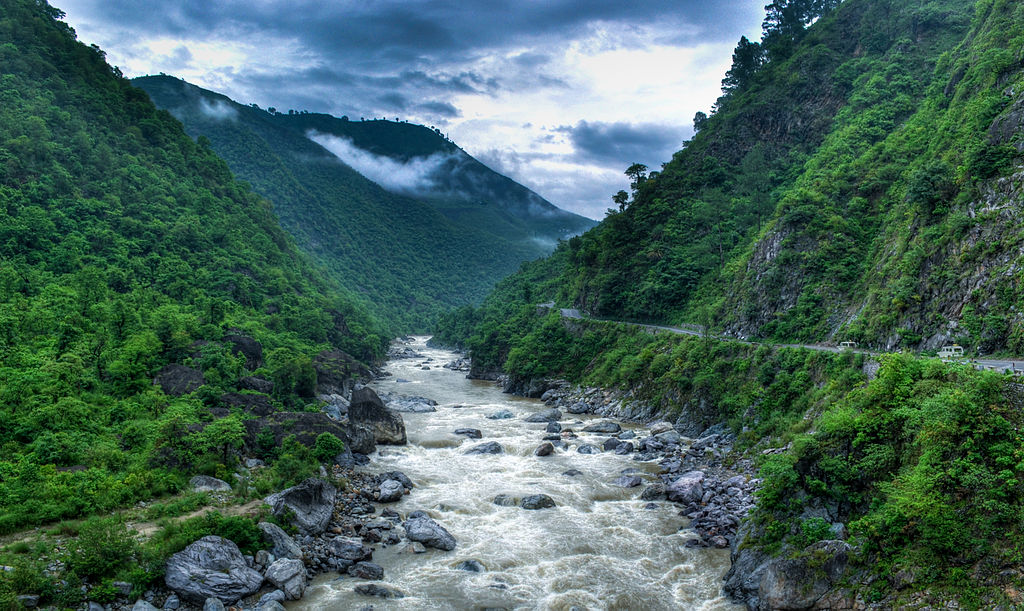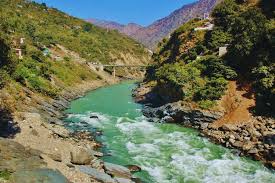In the Indian state of Uttarakhand, Kumaon (/ˈkɛmɔːʊ/; Kumaoni: Kumāū; pronounced [kuːmɔːʊ]; historically romanized as Kemāon[6][7]) is a division that handles revenue and administration. It covers the eastern half of the state and is bordered by Garhwal to the west, the state of Uttar Pradesh to the south, Tibet to the north, and Nepal to the east. Almora, Bageshwar, Champawat, Nainital, Pithoragarh, and Udham Singh Nagar are the six districts that make up Kumaon.
Throughout history, the Kumaon region—first known as Manaskhand and later as Kurmanchal—has been governed by a number of dynasties, most notably the Katyuris and the Chands. When the British reclaimed this area from the Gorkhas, who had seized the former Kingdom, the Kumaon division was created in 1816.
Etymology
It is thought that Kumaon originated from Kurmanchal, which means the land of Kurma (the tortoise form of Vishnu, the Hindu preserver deity).[9][10]
The term Kumaon may have originated in the fifth century BC, according to another theory. After fleeing their native Kummah, which was located on the banks of the Euphrates River, the Kassite Assyrians relocated to northern India.
It was also called Kemaon during the period between 1815 and 1857 when the area was under British rule.

The Kumaon[12] region consists of a large Himalayan tract, together with two submontane strips called the Terai and the Bhabar. The submontane strips were up to 1850 an almost impenetrable forest, given up to wild animals; but after 1850 the numerous clearings attracted a large population from the hills, who cultivated the rich soil during the hot and cold seasons, returning to the hills in the rains. The rest of Kumaon is a maze of mountains, part of the Himalaya range, some of which are among the loftiest known. In a tract not more than 225 km in length and 65 km in breadth there are over thirty peaks rising to elevations exceeding 5500 m
History

North of the highest peaks, the southern slope of the Tibetan watershed is where rivers like the Gori, Dhauli, and Kali originate. From there, they flow through valleys that are exceptionally deep and rapidly declivity-prone. The Sharda (Kali Ganga), Pindari, and Kailganga are the main rivers whose waters merge with the Alaknanda. [13] India and Nepal are separated internationally by the Sharda (Kali Ganga) river. Along this river, the pilgrimage route that currently leads to Kailash-Mansarovar crosses into Tibet at Lipu Lekh pass.
The Himalayan cypress, pindrow fir, alder, sal, saindan, and chir pine are the main trees. The main geological formations are granite, gneiss, slate, sandstone, and limestone. Although there are iron, copper, gypsum, lead, and asbestos mines, they are not fully

North of the highest peaks, the southern slope of the Tibetan watershed is where rivers like the Gori, Dhauli, and Kali originate. From there, they flow through valleys that are exceptionally deep and rapidly declivity-prone. The Sharda (Kali Ganga), Pindari, and Kailganga are the main rivers whose waters merge with the Alaknanda.[13] India and Nepal are separated internationally by the Sharda (Kali Ganga) river. Along this river, the pilgrimage route that today leads to Kailash-Mansarovar crosses into Tibet at Lipu Lekh pass.
The Himalayan cypress, pindrow fir, alder, sal, saindan, and chir pine are the main trees. The main geological formations include granite, gneiss, slate, sandstone, and limestone. Although there are iron, copper, gypsum, lead, and asbestos mines, they are not fully
History
In the districts of Almora and Nainital, prehistoric homes and Stone Age tools have been found. Following waves of Kiratas, Khasas, and Indo-Scythians, the area was first populated by Kol tribal people. The area was first ruled by the Kunindas. The Katyuri kings of Khasha descent [14] succeeded them and ruled the area from 700 to 1200 AD. [9]
Kurmanchal was split up into eight distinct principalities around 1100–1200 AD following the breakup of the Katyuri kingdom: Baijnath-Katyur, Dwarhat, Doti, Baramandal, Askot, Sira, Sora, and Sui. Under Rudra Chand, the entire area was reunited as Kumaon circa 1581 AD.
Kumaon Kingdom
Katyuri Raj
Vashudev Katyuri established the Katyuri dynasty, a ruling Hindu dynasty of Khasha ancestry [14]. Between the 7th and 11th centuries AD, they founded their kingdom and called it the Kurmanchal Kingdom. They ruled over areas of Kumaon that ranged in size from the “Katyur” (present-day Baijnath) valley, and they made Baijnath, in the Bageshwar district—then known as Kartikeyapura—the capital of the “Katyur” valley. Katyuri king Brahma Deo founded Brahmadev Mandai in the Kanchanpur District of far western Nepal. At its height, the Katyuri kings’ Kurmanchal kingdom stretched from Sikkim in the east to Kabul, Afghanistan, in the west. However, by the 12th century, it had broken up into many smaller principalities.
From King Dham Deo, it is thought
